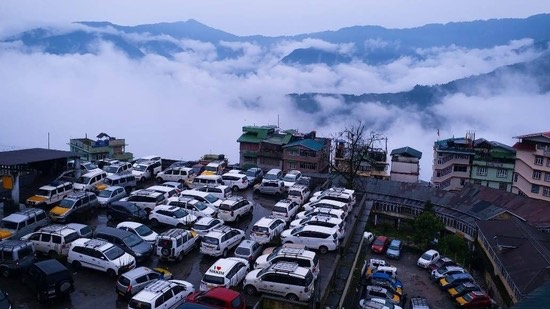Planning for the hills: Rethinking urban mobility in hill cities

Gangtok, the capital of Sikkim in northeast India, presents a compelling case for adapting sustainable urban mobility frameworks to better serve small hill cities.
Nestled in the Eastern Himalayas, Gangtok is home to just over 100,000 residents. Unlike the grid-like sprawl of many Indian cities in the plains, Gangtok’s streets wind along topographical contours, creating unique challenges for movement, both for people and for planning frameworks.
Despite its unique context, Gangtok remains largely absent from national mobility programs such as Smart Cities or the Atal Mission for Rejuvenation and Urban Transformation (AMRUT), which prioritise metropolitan centres. Similarly, tools like Sustainable Urban Mobility Plans (SUMPs) and National Urban Mobility Policies (NUMPs) are not yet fully calibrated for hill-town realities.
For Gangtok and similar cities to be meaningfully included in the global transition toward sustainable urban mobility, planning frameworks must evolve.
Key Priorities for Hill-Sensitive Mobility Planning
1. Adapting SUMPs for Terrain-Sensitive Contexts
Traditional SUMPs focus on network density, modal share, and emissions, but often ignore topographical constraints. In Gangtok, walkability and public transport access are fundamentally shaped by elevation. A reimagined approach to SUMPs could integrate:
- Slope-aware infrastructure audits
- Context-specific accessibility indicators
- Seasonal variations in mobility (e.g., monsoon or winter impacts)
2. Embracing Informal Transit Networks
Gangtok’s primary mode of public transport is a system of informal shared taxis, which connect neighbourhoods and nearby towns. These taxis are affordable, frequent, and agile in navigating narrow, winding roads. However, they operate largely outside the formal regulatory and data ecosystems, making integration into mobility plans difficult.
Rather than seeking to replace these systems, policymakers can:
- Introduce flexible operating permits
- Conduct participatory route mapping and safety audits
- Pilot digital scheduling platforms to improve reliability without compromising adaptability
3. Designing for Equity and Accessibility
Mobility systems must account for the lived experiences of all users, especially those often excluded from planning processes. In Gangtok, women, older adults, and low-income workers face compounded challenges due to steep inclines, narrow footpaths, and limited safe waiting areas.
Small, targeted improvements can make a big difference:
- Seating and shade at taxi stands
- Well-lit, stepped pedestrian pathways
- Safe crossings and gender-sensitive design in mobility hubs
4. Leveraging Community-Based Data
Data scarcity is a common challenge in smaller cities. In Gangtok, localised, community-led mobility assessments can fill data gaps and provide insights into travel behaviours and pain points. These participatory tools are especially valuable for identifying service gaps in informal transport and pedestrian infrastructure.
Scaling the Lessons
Gangtok’s challenges are not unique. Across the Himalayas and other mountainous regions globally, small cities are grappling with urban growth, ecological fragility, and the pressure to modernize transport networks without compromising social or environmental resilience. By adapting planning tools to local topographies and social realities, we can create mobility systems that are not only sustainable but also inclusive and terrain-aware.
Gangtok may not fit the standard image of an Indian city, but it offers a valuable experience of what movement means when the ground beneath your feet is anything but flat.
|

|
This article is a volunteer contribution by Eden Bhutia, an architecture graduate and cities postgraduate from Central Saint Martins, UAL, UK. Her work focuses on feminist and ecological approaches to mobility in the Eastern Himalayas. She is also a climate advocate with the Climate Security Mechanism (CSM) and supports inclusive urban projects through Creative Youth Opportunities. |
Interested in contributing to MobiliseYourCity news & highlights? Reach out to us at contact@mobiliseyourcity.net.